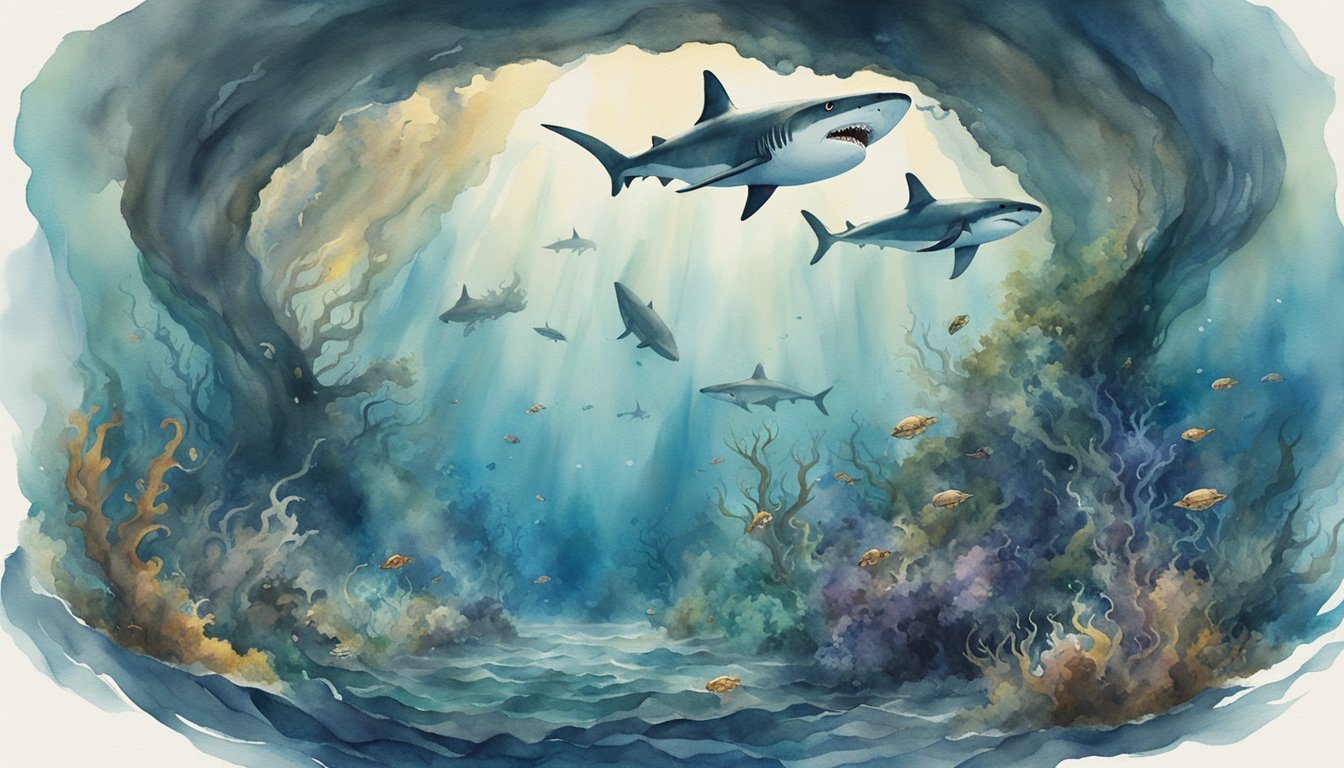Mysterious Depths and Predators of the Ocean
The ocean’s depths are home to some of the most enigmatic and frightening creatures on Earth, enduring crushing pressure and complete darkness.
Unexplored Abyss
The deep sea, particularly regions such as the Mariana Trench, remains one of the least explored places on our planet. Here, the absence of light creates an environment where only the most adaptable survive. Within this void, the vampire squid thrives, using bioluminescence to navigate and communicate in the perpetual night. At these depths, pressure soars to unimaginable levels, yet the gelatinous blobfish copes with the extreme force by having a density slightly less than water.
Deadliest Inhabitants
The deep ocean is a sanctuary for some of the ocean’s most lethal predators. Among them, the goblin shark stands out with its uniquely protruding jaw and nail-like teeth, while the prehistoric-looking frilled shark, reminiscent of serpentine myths, silently roams the depths. Sometimes referred to as “living fossils,” creatures like the ghost shark or chimaera hover in deep waters. These relatives of sharks feature elongated, wing-like pectoral fins and haunting, translucent skin. Additionally, the abyss is inhabited by creatures straight from a science fiction story, such as the giant sea spider and the fierce-looking fangtooth, which holds the record for the largest teeth relative to body size among deep-sea fish. The elusive anglerfish, with its luminescent lure, preys on unsuspecting victims that wander too close to its maw.
Threats and Terror Below the Waves

While the ocean’s surface often reflects serene beauty, beneath the waves lie natural dangers and uniquely adapted predators that can be as fascinating as they are fearsome.
Dangerous Encounters
Sharks often headline as the most frightening predators in the sea, with the Great White Shark being a notable example due to its size, power, and media portrayal. While statistically rare, shark attacks do occur, and understanding these creatures’ behavior is key to mitigating the risks. Meanwhile, the waters of Australia are known for harboring the potent Australian Box Jellyfish, whose sting can be lethally venomous to humans. Venturing into the domain of these creatures necessitates awareness and respect for their capabilities.
Menacing Phenomena
Aside from living hazards, the ocean is home to mystifying and perilous phenomena like the infamous Bermuda Triangle, where ships and planes have been said to disappear under mysterious circumstances. On a different note, natural disasters like tsunamis are a formidable force arising from the ocean’s depths, capable of reshaping coastlines and claiming lives. A brief reminder of these perils can be found in the powerful geological processes that create underwater sinkholes, drawing in the surrounding sea life—and the curious diver too.
Wrecks and Relics of the Deep

The ocean floor is a tapestry of maritime history with numerous ship and aircraft wrecks, each telling a tale of the past. They paint a picture of battles long fought, lives lost, and the inevitable embrace of the deep.
Ship and Aircraft Graveyards
Ship graveyards are scattered across the ocean’s vast domain, with an eerie collection of skeletons, ships, and aircrafts embraced by coral and sea life. One notable site is off the coast of New Jersey, where numerous shipwrecks lie due to its history as a key shipping route. Divers from around the world venture here to experience the unique thrill of encountering history beneath the waves.
Another profound underwater graveyard is Truk Lagoon in the Pacific, which became the cemetery for Japan’s most formidable naval fleet after Operation Hailstone in WWII. The site’s combination of military shipwrecks and fallen aircraft is not only a haven for marine life but also a poignant reminder of the lives lost. It is one of the many underwater sites monitored by the National Oceanic and Atmospheric Administration (NOAA).
Mysteries of Maritime History
Maritime history is rife with mysteries, and among the most compelling artifacts retrieved is the Antikythera mechanism, often regarded as the world’s oldest known analog computer. Discovered in Greece, near the island of Antikythera, it evidences the intriguing complexity of ancient maritime technology.
Canada’s own mysteries include the numerous and sometimes mysterious shipwrecks within the Great Lakes, which have been a focal point for divers and archaeologists alike. Similarly, Alexandria’s submerged ruins hold secrets of ancient civilizations, now silent beneath the sea. Skeletons of age-old soldiers and remnants of their arsenals have been found, giving insight into long-forgotten battles.
Then there are places like the Great Blue Hole in Belize, a giant marine sinkhole, where divers go to explore and sometimes never return, adding to the list of unsolved disappearances. The combination of natural wonders and human history makes the ocean an eternally fascinating subject for exploration and storytelling.

